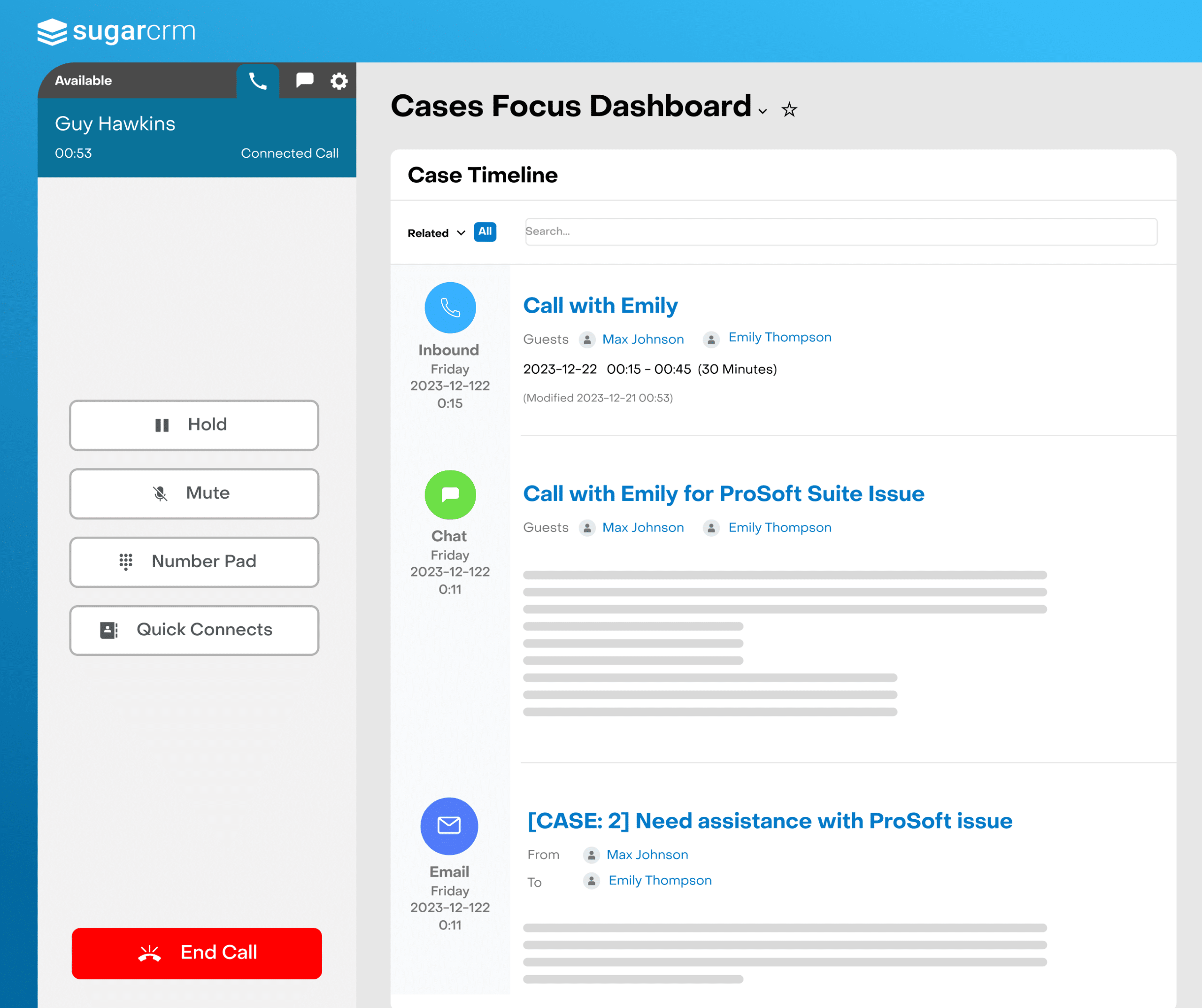The Power of All-in-One CRM: Aligning IT Leaders with Key Business Objectives
An “All-in-One” CRM refers to a comprehensive Customer Relationship Management (CRM) system that combines multiple functionalities and features into a single software solution. It aims to provide a centralized platform for managing various aspects of customer relationships and business operations.
Typically, an All-in-One CRM includes core Sales, Marketing, and Service CRM capabilities such as:
- Contact and lead management
- Sales pipeline tracking
- Customer interaction history
- Marketing automation
- Customer support ticketing
- Project management
- Invoicing
- Analytics
- And more.
The goal is to offer businesses a unified solution that encompasses multiple departments and streamlines their processes.
But it also offers department administration ownership, allowing IT to delegate the day to day operations and the department the ability to handle all of their team’s requirements directly from the platform. A CRM with a 360-degree view of organizational operations eliminates the need for IT to allocate resources to manage the platform. This allows them to both streamline operations and contribute to the growth and scalability of the business, all while minimizing IT-related challenges and complications
By using an All-in-One CRM, organizations can benefit from having a holistic view of their customers and streamlined operations. It eliminates the need for using multiple software applications, reduces data silos, and promotes efficient collaboration across teams. Users can access and manage customer data, track sales activities, automate marketing campaigns, handle customer support requests, and monitor key performance metrics, all within a single platform.
Overall, an All-in-One CRM aims to provide a comprehensive solution that caters to various business needs, enhances customer relationships, and improves overall operational efficiency. Below are four of the top ways IT leaders can benefit from implementing an All-in-One CRM platform:
1. Control and Protect Your Data and CRM Environment
An All-in-One CRM can control and protect your data and CRM environment through various measures and features. Here are some ways it can accomplish this:
Data Security, Backup, and Recover
An All-in-One CRM should employ robust security measures to protect your data from unauthorized access, data breaches, and cyber threats. This can include encryption of data at rest and in transit, regular security audits, and adherence to industry standards and best practices.
At the same time, a reliable All-in-One CRM should have automated data backup mechanisms in place. Regular backups help protect your data from accidental loss, system failures, or other unforeseen events. Additionally, the CRM should offer recovery options to restore data in case of any data loss.
Moreover, this type of CRM ensures that each department has control over their specific functionalities and data within the platform. With specific permissions granted to each department, IT can establish granular permissions and controls, granting appropriate access levels to different user groups, which further enhances security and compliance measures.
Compliance and Regulations
In today’s age with so many new privacy laws, compliance has taken center stage in a lot of conversations. An All-in-One CRM should adhere to relevant data protection regulations depending on your jurisdiction and include relevant features such as consent management, data retention policies, and the ability to handle data subject access requests.
Secure Integrations
If the CRM integrates with other applications or services, it should follow secure integration practices. This involves using secure protocols, validating API access, and ensuring data privacy when exchanging information with external systems.
By implementing these control and protection measures, an All-in-One CRM helps ensure the security, integrity, and confidentiality of your data, as well as the overall CRM environment.
2. Reduce Cost and Complexity
An All-in-One CRM can help reduce costs and complexities in your business in several ways:
Streamlined Processes
By centralizing various customer-related activities and information within a single source of truth, an All-in-One CRM eliminates the need for multiple siloed and disjointed systems. When your CRM processes can talk to each other, organizations can benefit from streamlined processes and reduced complexity by providing a unified view of all sales, marketing, and customer service activities. This minimizes the time and effort required to switch between different systems, leading to increased efficiency and productivity.
The adoption of such a platform not only brings convenience and autonomy to each department, it also streamlines overall workflow and reduces operational friction. By delegating administrative tasks to the respective teams, IT can avoid becoming a bottleneck for routine requests, enabling faster decision-making and increased agility within the organization.
Saved Time and Enhanced Productivity
A connected CRM gives organizations the luxury of saved time because it can automate manual tasks and workflows, such as lead assignment, follow-ups, and data entry. When organizations can reduce their reliance on these types of manual processes, employees can focus on more value-added activities, such as building customer relationships and closing deals. This type of automation can lead to increased productivity, reduced human error, and ultimately, cutting unnecessary operational cost.
By implementing an all-in-one platform, IT can also ensure that each department has access to a comprehensive set of tools and features necessary for their day-to-day activities. Instead of relying on IT to handle administrative tasks, such as user provisioning, access controls, and software updates, sales, marketing, and service leaders can independently manage their teams’ needs within the platform.
Metrics & KPIs
A connected CRM can provide companies with valuable insights and analytics on various metrics, such as sales performance, customer behavior, and marketing ROI. These insights help businesses make informed decisions, optimize processes, and identify areas for improvement, which can all lead to a reduction in business costs traditionally associated with ineffective strategies or inefficient operations.
Scalability and Flexibility
An All-in-One CRM can grow and adapt with your business. As your business expands, you can easily scale up the CRM system without the need for significant infrastructure investments or complex integrations. This scalability and flexibility save costs associated with system upgrades, migrations, or the adoption of new tools.
Furthermore, a single source of truth CRM contributes to the scalability of the business. As new teams or departments are added, they can easily onboard onto the platform and independently manage their operations. The platform’s flexibility allows for seamless expansion, accommodating the evolving needs of the organization without relying heavily on IT support.
3. Optimize Company Resources
With an All-in-One CRM, you can better allocate resources such as sales representatives, customer support agents, and marketing teams.
Resource Allocation:
The CRM system provides insights into customer interactions, sales pipelines, and support tickets, enabling you to assign resources based on demand and priority. This ensures that resources are efficiently utilized, leading to increased productivity and cost savings. Companies should learn to lean on a CRM that has the technology and the capability to support anybody anywhere in the world with cloud technology.
This shift in responsibility also allows IT to focus their resources and expertise on more strategic initiatives and high-priority projects. With reduced involvement in routine administrative tasks, IT professionals can allocate their time and efforts to enhance the overall technology infrastructure, explore innovative solutions, and implement improvements that contribute to the organization’s success.
Mobile:
An All-in-One CRM can also optimize mobile resources by providing mobile-friendly features and functionalities that enable employees to efficiently access and utilize CRM data while on the go.
4. Prioritize Organizational Alignment
An All-in-One CRM can align innovation with business objectives by providing tools and functionalities that support and enhance the achievement of those objectives.
Business Objectives
By offering customization, integration capabilities, innovation management features, data analytics, collaboration tools, scalability, and user adoption support, an All-in-One CRM can effectively align innovation initiatives with business objectives. It empowers businesses to leverage the CRM system as a catalyst for innovation, driving growth and achieving strategic goals.
Collaboration and Communication
An All-in-One CRM should support collaboration and communication among team members, enabling cross-functional teams to work together on innovative projects. By fostering collaboration, the CRM ensures that innovation efforts are aligned with business objectives and benefit from diverse perspectives and expertise. It allows for easy sharing of customer information, communication history, and task assignments. This improves coordination and eliminates communication gaps, leading to smoother workflows, reduced duplication of efforts, and increased productivity.
CRM: The Single Source of Truth
By offering a comprehensive suite of features, an All-in-One CRM aims to centralize customer-related data and streamline business processes, enabling businesses to enhance customer relationships, improve sales effectiveness, and optimize marketing efforts within a single platform. When each department has the ability to handle its needs on its own, the role of IT is ultimately transformed.
When the burden of administration is automated, IT professionals can then turn their focus on more strategic initiatives, while all other teams gain the autonomy, efficiency, and the ability they need to simplify their day-to-day life. This collaborative approach to CRM gives organizations the ability to foster a more productive and harmonious relationship between IT and the various departments, reducing IT headaches and ensuring the successful growth of the business.
Interested in learning more about how the right CRM can help you optimize and connect your sales processes and tech stack? Download our guide, CRO Update: AI and Digital Sales Transformation.
Or, want to learn more about the topic? Visit our Blog section! We have many resources discussing it, or contact our team!


